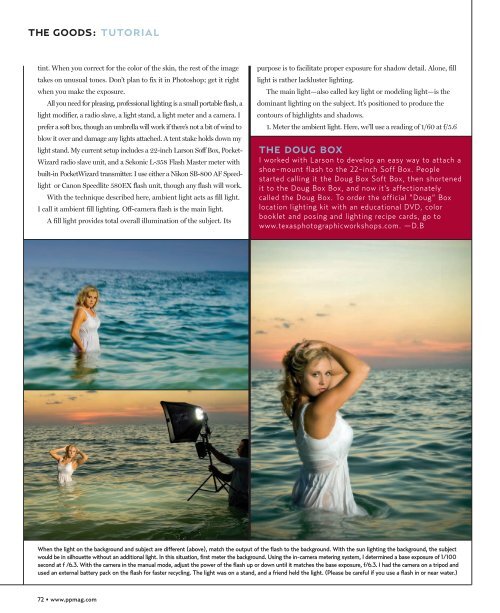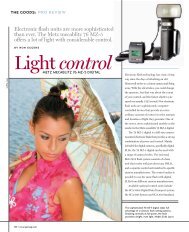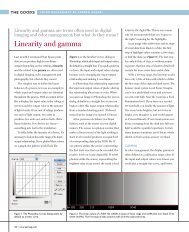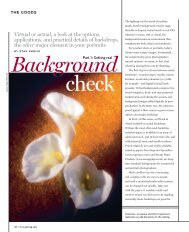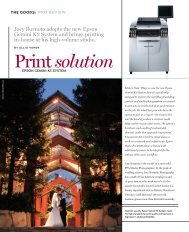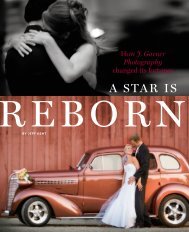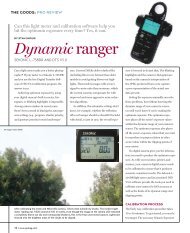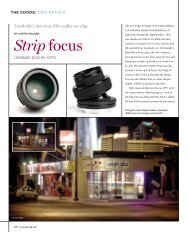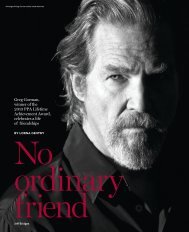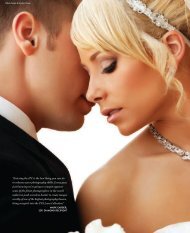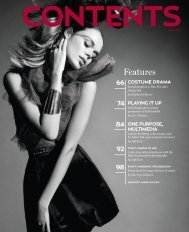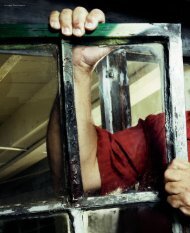january 2007 - Professional Photographer Magazine
january 2007 - Professional Photographer Magazine
january 2007 - Professional Photographer Magazine
Create successful ePaper yourself
Turn your PDF publications into a flip-book with our unique Google optimized e-Paper software.
THE GOODS: TUTORIAL<br />
tint. When you correct for the color of the skin, the rest of the image<br />
takes on unusual tones. Don’t plan to fix it in Photoshop; get it right<br />
when you make the exposure.<br />
All you need for pleasing, professional lighting is a small portable flash, a<br />
light modifier, a radio slave, a light stand, a light meter and a camera. I<br />
prefer a soft box, though an umbrella will work if there’s not a bit of wind to<br />
blow it over and damage any lights attached. A tent stake holds down my<br />
light stand. My current setup includes a 22-inch Larson Soff Box, Pocket-<br />
Wizard radio slave unit, and a Sekonic L-358 Flash Master meter with<br />
built-in PocketWizard transmitter. I use either a Nikon SB-800 AF Speedlight<br />
or Canon Speedlite 580EX flash unit, though any flash will work.<br />
With the technique described here, ambient light acts as fill light.<br />
I call it ambient fill lighting. Off-camera flash is the main light.<br />
A fill light provides total overall illumination of the subject. Its<br />
72 • www.ppmag.com<br />
purpose is to facilitate proper exposure for shadow detail. Alone, fill<br />
light is rather lackluster lighting.<br />
The main light—also called key light or modeling light—is the<br />
dominant lighting on the subject. It’s positioned to produce the<br />
contours of highlights and shadows.<br />
1. Meter the ambient light. Here, we’ll use a reading of 1/60 at f/5.6<br />
THE DOUG BOX<br />
I worked with Larson to develop an easy way to attach a<br />
shoe-mount flash to the 22-inch Soff Box. People<br />
started calling it the Doug Box Soft Box, then shortened<br />
it to the Doug Box Box, and now it’s affectionately<br />
called the Doug Box. To order the official “Doug” Box<br />
location lighting kit with an educational DVD, color<br />
booklet and posing and lighting recipe cards, go to<br />
www.texasphotographicworkshops.com. —D.B<br />
When the light on the background and subject are different (above), match the output of the flash to the background. With the sun lighting the background, the subject<br />
would be in silhouette without an additional light. In this situation, first meter the background. Using the in-camera metering system, I determined a base exposure of 1/100<br />
second at f /6.3. With the camera in the manual mode, adjust the power of the flash up or down until it matches the base exposure, f/6.3. I had the camera on a tripod and<br />
used an external battery pack on the flash for faster recycling. The light was on a stand, and a friend held the light. (Please be careful if you use a flash in or near water.)


